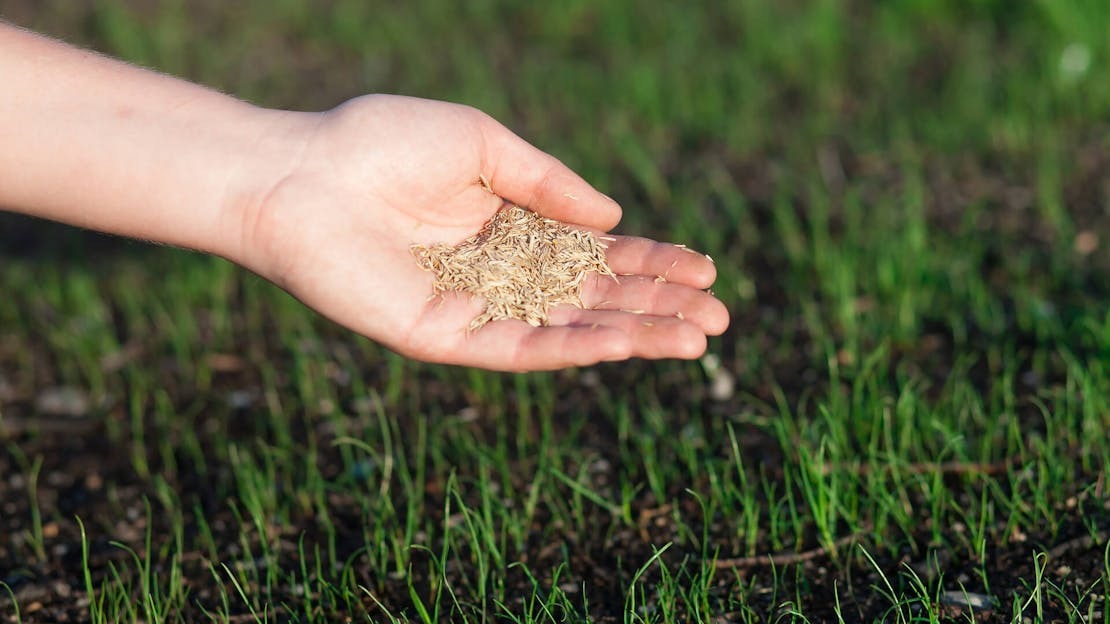
When Can I Sow Grass Seed?
Temperature and moisture are the two main factors when it comes to planting and germinating grass seed, whether that's for a new lawn or when over seeding.
The Correct Temperature for Sowing Grass Seed
Temperature is the main guide for sowing seed. If it’s too cold it won’t germinate so consider 100 C soil temperature a minimum with 150 C being optimum. As a rough guide the soil temperature is an average of the night and day air temperature over a week.
This means the best seeding time is usually from April to September. Even then, the long range forecast and average outside temperature should be considered before committing. Unfortunately, many people get a little gung ho in March if there is a mild spell and start seeding only to be hit with cold weather and potentially dead seed if frost penetrates a germinating seed. Our bags of seed state to sow from April to September to prevent a too early start and obvious disappointment.
It is quite often possible to seed in October, particularly if you live in the southern half of the country. Just look at the long-range forecast and make a decision. There can be a risk of poor germination, but if you have a bare or scarified lawn, it's usually best to take the risk and seed. If you don't, you'll definitely have an ugly lawn for quite a few months and plenty of weeds by spring!
Last thing to consider is that shady areas are colder than sunny spots so let things warm up before seeding areas shaded by buildings or fences in the spring. Shading from trees shouldn't be a problem if done in spring. Your objective here is to get the seed germinating well before the tree gets a full canopy of leaves. Seeding around trees in autumn is a problem as you need to keep leaf fall off the new seedlings!
Avoid Lawn Weed Seeds when Sowing Grass Seed
Not often considered when planting a new lawn or scarifying and then over seeding. Most lawn weeds, like most other plants flower and seed anytime from March to July. Only a few will flower right through September.
This means sowing your grass seed when there are the fewest weed seeds about, unless you want a lawn full of dandelions! The choice therefore is to seed or over seed in autumn or if doing a spring sowing cover the seed as in plan C below.
The next consideration is water and who is providing it, you, or mother nature?
Can you Water your Grass Seed?
- If you have a lawn that is too large to water go to A below
- If you have a small to medium lawn but can’t water go to C
- If you have a small to medium lawn and can water go to B or C
Plan A - I need Rain to Germinate my Grass Seed
Spring Sowing:
Sow your grass seed when the soil is sufficiently moist once you get to 100 C soil temperature. Don’t wait for a higher temperature because the weather may then dry out!
Summer Sowing:
Can be risky as the ground can dry quickly in strong sun, but if it’s been wet and the forecast shows rain for the following 2 weeks then it should be a good opportunity.
Autumn Sowing:
In autumn you are sandwiched between summer dryness and declining temperature so plan to sow as soon as the ground is moist enough. From the end of August through September the temperature is usually warm enough to seed in most parts of the UK with those in the very south managing to seed into October more often than not.
Plan B - I can Water my Grass Seed
Then automatically go for a spring or autumn sowing due to less heat and drying from the sun.
Watering can get rather onerous as you mustn’t let the seed dry out. In dry warm weather this can mean a light watering every few hours which can be a big ask! If you don’t want to do that then plan C below is for you.
See the next page on How to Water Grass Seed
Plan C - I can Cover my Grass Seed
Spring and Autumn sowing should be covered with polythene. This protects from seed eating birds, torrential rain, drying weeds and means no need to water whilst the polythene is down. It also means seeding can be a bit earlier in spring or later in autumn as the polythene insulates the ground and increases the temperature by a few degrees.
If sowing in summer, use a plant or garden fleece to cover the seed, as covering with polythene in high temperatures can cook your grass! This still reduces evaporation a little but does need some watering to keep the seed from drying out. Germination is pretty fast in warm summer temperatures, so you shouldn’t have too long a task keeping the area watered.
Hopefully, you can now plan your sowing to take advantage of the weather and temperature, and at the same time, make life easier for you.